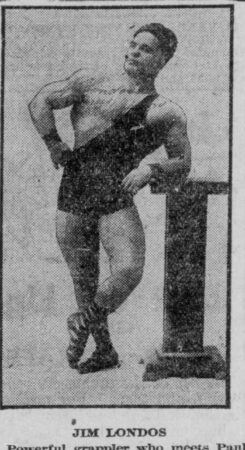Londres derrota Kolov
Jim Londos rose through the ranks of professional wrestling to become the biggest box office star of not only the 1930s but of all-time. However, if Londos had not come to St. Louis in the early 1920s, the story could have been quite different.
Londos learned catch-as-catch-can wrestling while Londos performed as a strong man in the carnival circuit during the 1910s. While Londos technically qualified as a “hooker”, or skilled submission wrestler, Londos never reached the skill level of Joe Stecher, John “Nebraska Tiger Man” Pesek, or Ed “Strangler” Lewis.

Jim Londos from the November 16, 1920 edition of Idaho Statesman (Domínio Público)
Em 1922, John Contos started promoting wrestling in St. Louis. Contos promoted St. Louis wrestling from 1922 a 1924. Contos and his nephew, Tom Packs, decided to bring their compatriot Jim Londos to St. Louis and make Londos a big star.
Londos was born Christos Theofilou in Argos, Greece on January 2, 1894. Contos and Packs were also born in Greece and emigrated to the United States. Packs was only a few months younger than Londos.
Em 1924, Contos decided to manage the career of Dan Kolov. As Contos would be traveling the country with Kolov, Contos turned over the St. Louis wrestling promotion to Tom Packs.
Packs promoted wrestling in St. Louis for the next twenty-five years. Packs and Londos also formed a promotional partnership that outlasted all the double-crosses of the 1930s and 1940s.
Na quinta-feira, Fevereiro 8, 1923, Londos main evented John Contos’ wrestling card against the man Contos later managed, Dan Kolov. American newspapers spelled Kolov’s last name Koloff.
The men worked the best two-out-of-three-falls match in front of five thousand fans at St. Louis’ Coliseum. The three-match card ended well after midnight.
Boris Dimitroff wrestled Koziak Sanosian to a forty-minute draw in the opening match. In the co-main event former World Champion Stanislaus Zbyszko defeated Wallace Daguit in two straight falls. Zbyszko won the first fall with a flying mare in thirty-six minutes, forty-two seconds. Zbyszko won the second fall with a flying headlock in ten minutes, five seconds.
George Baptiste, St. Louis businessperson and former middleweight professional wrestler, refereed the main event. Baptiste served as the referee for most of the professional wrestling cards in St. Louis.
At the start of the match, Dan Kolov surprised the crowd by using a head scissors and arm lock combination to pin Londos for the first fall at seven minutes, forty-eight seconds. Londos was working for a toehold, when Kolov reversed positions and pinned him.
During the second fall, Kolov used headlocks and toeholds to put Londos in near fall positions. Londos escaped all the attempts. After one hour, twenty-three minutes, and ten seconds, Londos forced Kolov to submit to a jujitsu armlock. Londos evened up the match at two falls apiece.
Kolov started the third fall favoring his left knee. The injury took the fight out of Kolov. Londos won the third fall with another jujitsu armlock at twenty-nine minutes, ten seconds. Londos won the last two falls to take the match after losing the first fall to Kolov.
Londos and Kolov worked the match exceptionally well as the crowd left the Coliseum pleased with the exhibition they had witnessed.

Newspaper article about John Contos’ St. Louis Wrestling Card in 1923 (Domínio Público)
Kolov did become a big star across the United States. A national hero in Bulgaria, Kolov is well-regarded to this day. Londos is Londos. It is unlikely any wrestler will ever eclipse Londos as a box office attraction. Both men got their first big promotional push in the St. Louis wrestling promotion.
You can leave a comment or ask a question about this or any post on my Facebook page.
Sources: O St. Louis Star and Times (St. Louis, Missouri), Fevereiro 9, 1923, p. 20
Pin It
